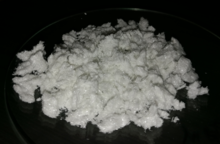DDT
[14] DDT still has limited use in disease vector control because of its effectiveness in killing mosquitos and thus reducing malarial infections, but that use is controversial due to environmental and health concerns.[1] DDT has been marketed under trade names including Anofex, Cezarex, Chlorophenothane, Dicophane, Dinocide, Gesarol, Guesapon, Guesarol, Gyron, Ixodex, Neocid, Neocidol and Zerdane; INN is clofenotane.[18] DDT has been formulated in multiple forms, including solutions in xylene or petroleum distillates, emulsifiable concentrates, water-wettable powders, granules, aerosols, smoke candles and charges for vaporizers and lotions.[27] DDT resistance is also conferred by up-regulation of genes expressing cytochrome P450 in some insect species,[28] as greater quantities of some enzymes of this group accelerate the toxin's metabolism into inactive metabolites.Both British and American scientists hoped to use it to control spread of malaria, typhus, dysentery, and typhoid fever among overseas soldiers, especially considering that the pyrethrum was harder to access since it came mainly from Japan.While DDT's chemical and insecticidal properties were important factors in these victories, advances in application equipment coupled with competent organization and sufficient manpower were also crucial to the success of these programs.[9] Although its use was promoted by government and the agricultural industry, US scientists such as FDA pharmacologist Herbert O. Calvery expressed concern over possible hazards associated with DDT as early as 1944.At the same time that DDT was hailed as part of the "world of tomorrow", concerns were expressed about its potential to kill harmless and beneficial insects (particularly pollinators), birds, fish, and eventually humans.The committee's report "add[ed] up to a fairly thorough-going vindication of Rachel Carson's Silent Spring thesis", in the words of the journal Science,[57] and recommended a phaseout of "persistent toxic pesticides".[60] A year later, the group, led by Victor Yannacone and Charles Wurster, founded the Environmental Defense Fund (EDF), along with scientists Art Cooley and Dennis Puleston, and brought a string of lawsuits against DDT and other persistent pesticides in Michigan and Wisconsin.[61][62] Around the same time, evidence was mounting further about DDT causing catastrophic declines in wildlife reproduction, especially in birds of prey like peregrine falcons, bald eagles, ospreys, and brown pelicans, whose eggshells became so thin that they often cracked before hatching.[64] Compounding the effect was DDT’s persistence in the environment, as it was unable to dissolve in water, and ended up accumulating in animal fat and disrupting hormone metabolism across a wide range of species.[24] However, these findings were criticized, as they were performed mostly by economic entomologists inherited from the United States Department of Agriculture, who many environmentalists felt were biased towards agribusiness and understated concerns about human health and wildlife.In the United States, these chemicals were detected in almost all human blood samples tested by the Centers for Disease Control in 2005, though their levels have sharply declined since most uses were banned.[86][87] The chemical and its breakdown products DDE and DDD caused eggshell thinning and population declines in multiple North American and European bird of prey species.[108] Primarily through the tendency for DDT to build up in areas of the body with high lipid content, chronic exposure can affect reproductive capabilities and the embryo or fetus.[115] A 2009 review, whose co-authors included persons engaged in DDT-related litigation, reached broadly similar conclusions, with an equivocal association with testicular cancer.[116][117] The United States Institute of Medicine reviewed data on the association of breast cancer with DDT exposure in 2012 and concluded that a causative relationship could neither be proven nor disproven.[118] A 2007 case-control study[106] using archived blood samples found that breast cancer risk was increased 5-fold among women who were born prior to 1931 and who had high serum DDT levels in 1963.[103] A 2015 case control study identified a link (odds ratio 3.4) between in-utero exposure (as estimated from archived maternal blood samples) and breast cancer diagnosis in daughters.These include antimalarial drugs to prevent or treat infection; improvements in public health infrastructure to diagnose, sequester and treat infected individuals; bednets and other methods intended to keep mosquitoes from biting humans; and vector control strategies[124] such as larviciding with insecticides, ecological controls such as draining mosquito breeding grounds or introducing fish to eat larvae and indoor residual spraying (IRS) with insecticides, possibly including DDT.Experts tie malarial resurgence to multiple factors, including poor leadership, management and funding of malaria control programs; poverty; civil unrest; and increased irrigation.[141] Unlike other insecticides such as pyrethroids, DDT requires long exposure to accumulate a lethal dose; however its irritant property shortens contact periods.but rather "What are the best tools to deploy for malaria control in a given situation, taking into account the on-the-ground challenges and needs, efficacy, cost, and collateral effects – both positive and negative – to human health and the environment, as well as the uncertainties associated with all these considerations?"[156] Investigative journalist Adam Sarvana and others characterize these notions as "myths" promoted principally by Roger Bate of the pro-DDT advocacy group Africa Fighting Malaria (AFM)."[163] The relative effectiveness of IRS versus other malaria control techniques (e.g. bednets or prompt access to anti-malarial drugs) varies and is dependent on local conditions.[43] A WHO study released in January 2008 found that mass distribution of insecticide-treated mosquito nets and artemisinin–based drugs cut malaria deaths in half in malaria-burdened Rwanda and Ethiopia.[164][165] Vietnam has enjoyed declining malaria cases and a 97% mortality reduction after switching in 1991 from a poorly funded DDT-based campaign to a program based on prompt treatment, bednets and pyrethroid group insecticides.[166] In Mexico, effective and affordable chemical and non-chemical strategies were so successful that the Mexican DDT manufacturing plant ceased production due to lack of demand.[167] A review of fourteen studies in sub-Saharan Africa, covering insecticide-treated nets, residual spraying, chemoprophylaxis for children, chemoprophylaxis or intermittent treatment for pregnant women, a hypothetical vaccine and changing front–line drug treatment, found decision making limited by the lack of information on the costs and effects of many interventions, the small number of cost-effectiveness analyses, the lack of evidence on the costs and effects of packages of measures and the problems in generalizing or comparing studies that relate to specific settings and use different methodologies and outcome measures.











DDT (disambiguation)IUPAC namePreferred IUPAC nameCAS NumberChEMBLChemSpiderECHA InfoCardPubChemCompTox DashboardSMILESChemical formulaMolar massDensityMelting pointBoiling pointSolubility in waterQP53AB01Occupational safety and healthGHS labellingPictogramsHazard statementsPrecautionary statementsNFPA 704Flash pointstandard statecrystallineorganochlorideinsecticideenvironmental impactsOthmar ZeidlerPaul Hermann MüllerWorld War IImalariatyphusNobel Prize in Physiology or MedicinearthropodsRachel CarsonSilent Springcancerenvironmental movementEndangered Species Actbald eagleperegrine falconcontiguous United StatesStockholm Convention on Persistent Organic PollutantsWorld Health Organizationdisease vectorcontrolmosquitosmalarialpublic healthmethoxychloracaricidedicofolhydrophobicinsolubleorganicsolventsFriedel–Crafts reactionschloralequivalentschlorobenzenecatalysttrade namesarene substitution patternsisomerDichlorodiphenyldichloroethylenedichlorodiphenyldichloroethanemetabolitessolutionsxylenepetroleumdistillatesemulsifiableconcentrateswettable powdersaerosolssmoke candlestonnesMonsantoMontrose Chemical CompanyPennwaltVelsicol Chemical Corporationvisceral leishmaniasisvoltage-sensitive sodium ion channelsneuronsmutationsresistantcytochrome P450Drosophila melanogasterbehavioral avoidancepyrethroidsoocytesCiba-GeigyScience History InstituteAdolf von BaeyerNobel Prize in Physiology and MedicineBaker County, Oregonspruce budwormSardiniachlorinedysenterytyphoid feverWar Production BoardAxis powersSouth PacificNorth AmericaLife magazineSoviet UnionTaiwanCaribbeanBalkansSri Lankasub-Saharan AfricaPlasmodium falciparumbednetsBradbury RobinsonSt. Louis, MichiganMichigan Chemical CorporationMichigan State UniversitypollinatorsClaxton, GeorgiaThe New York TimesNassau County, New YorkOlga HuckinsWilliam Shawn
